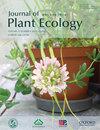Effects of pesticide application and plant sexual identity on leaf physiological traits and phyllosphere bacterial communities
IF 3
2区 环境科学与生态学
Q2 ECOLOGY
引用次数: 1
Abstract
Pesticides are widely used to enhance food production on a global scale. However, little information is available on the effects of pesticide application on leaf physiology and phyllosphere bacterial communities of dioecious plants. Therefore, this study aimed to assess the impact of λ-cyhalothrin, a broad-spectrum pesticide, on leaf physiology and phyllosphere bacterial communities in the dioecious Populus cathayana. Physiological leaf traits such as photosynthetic apparatus (net photosynthetic rate (Pn), stomatal conductance (gs), and transpiration (E)) of males were significantly higher than those of females, independent of pesticide use. In contrast, pesticide application significantly reduced the photosynthetic apparatus for both sexes, and the reduction was greater in males relative to females. Also, pesticide application significantly increased peroxidase (POD) activity and malondialdehyde (MDA) content and maintained superoxide dismutase (SOD) activity and total chlorophyll content in leaves of males. The phyllosphere bacteria showed some conserved characteristics, in which, Simpson and Shannon diversity indices were not affected by sex or pesticide application. Phyllosphere bacterial community composition differed between females and males indicating that intrinsic sex significantly shaped the phyllosphere bacteria community. However, pesticide application significantly increased the relative abundance of Actinobacteria but reduced the relative abundance of Proteobacteria. Principal component analysis showed associations between leaf physiology and specific bacterial taxa. For instance, Proteobacteria negatively correlated with leaf SOD activity and MDA content, while Actinobacteria showed an opposite pattern. Our study highlights sex-specific phyllosphere bacterial community composition and leaf physiological traits in dioecious plants.施用农药和植物性别认同对叶片生理性状和叶根圈细菌群落的影响
农药在全球范围内被广泛用于提高粮食生产。然而,关于施用杀虫剂对雌雄异株植物的叶片生理和叶际细菌群落的影响,目前知之甚少。因此,本研究旨在评估广谱杀虫剂λ-氯氟氰菊酯对雌雄异株山杨叶片生理和叶际细菌群落的影响。雄性的光合器(净光合速率(Pn)、气孔导度(gs)和蒸腾作用(E))等生理叶片性状显著高于雌性,与农药使用无关。相反,施用杀虫剂显著减少了两性的光合器官,而且雄性的减少幅度大于雌性。此外,施用农药显著提高了雄性叶片中过氧化物酶(POD)活性和丙二醛(MDA)含量,并保持了超氧化物歧化酶(SOD)活性和总叶绿素含量。叶层细菌表现出一些保守性特征,其中Simpson和Shannon多样性指数不受性别或农药施用的影响。叶层细菌群落组成在雌性和雄性之间存在差异,表明内在性别显著影响了叶层细菌的群落。然而,施用农药显著增加了放线菌的相对丰度,但降低了变形菌的相对丰富度。主成分分析表明,叶片生理学和特定细菌类群之间存在关联。例如,变形菌与叶片SOD活性和MDA含量呈负相关,而放线菌则表现出相反的模式。我们的研究强调了雌雄异株植物的性别特异性叶际细菌群落组成和叶片生理特征。
本文章由计算机程序翻译,如有差异,请以英文原文为准。
求助全文
约1分钟内获得全文
求助全文
来源期刊

Journal of Plant Ecology
生物-植物科学
CiteScore
4.60
自引率
18.50%
发文量
134
审稿时长
3 months
期刊介绍:
Journal of Plant Ecology (JPE) serves as an important medium for ecologists to present research findings and discuss challenging issues in the broad field of plants and their interactions with biotic and abiotic environment. The JPE will cover all aspects of plant ecology, including plant ecophysiology, population ecology, community ecology, ecosystem ecology and landscape ecology as well as conservation ecology, evolutionary ecology, and theoretical ecology.
 求助内容:
求助内容: 应助结果提醒方式:
应助结果提醒方式:


